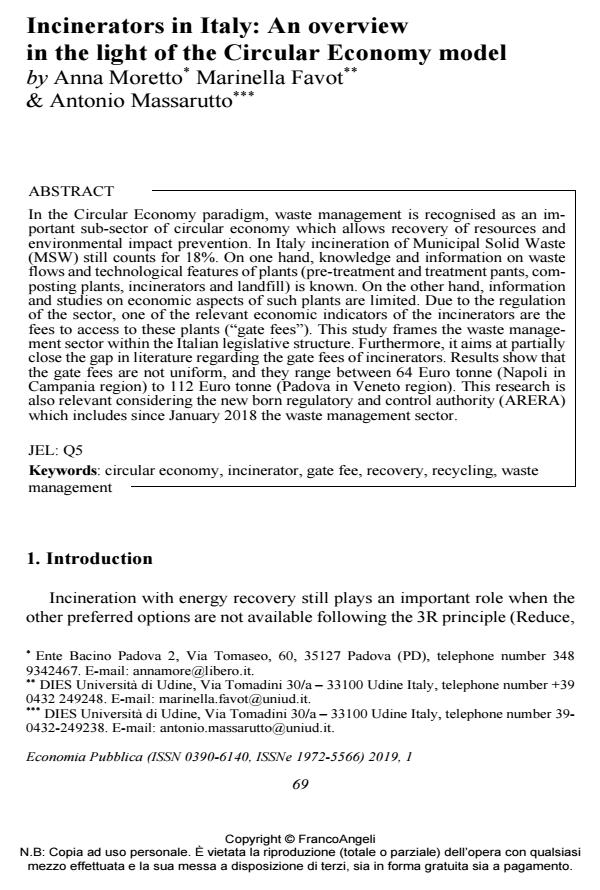Incinerators in Italy: An overview in the light of the Circular Economy model
Journal title ECONOMIA PUBBLICA
Author/s Anna Moretto, Marinella Favot, Antonio Massarutto
Publishing Year 2019 Issue 2019/1
Language English Pages 20 P. 69-88 File size 230 KB
DOI 10.3280/EP2019-001004
DOI is like a bar code for intellectual property: to have more infomation
click here
Below, you can see the article first page
If you want to buy this article in PDF format, you can do it, following the instructions to buy download credits

FrancoAngeli is member of Publishers International Linking Association, Inc (PILA), a not-for-profit association which run the CrossRef service enabling links to and from online scholarly content.
In the Circular Economy paradigm, waste management is recognised as an important sub-sector of circular economy which allows recovery of resources and environmental impact prevention. In Italy incineration of Municipal Solid Waste (MSW) still counts for 18%. On one hand, knowledge and information on waste flows and technological features of plants (pre-treatment and treatment pants, composting plants, incinerators and landfill) is known. On the other hand, information and studies on economic aspects of such plants are limited. Due to the regulation of the sector, one of the relevant economic indicators of the incinerators are the fees to access to these plants ("gate fees"). This study frames the waste management sector within the Italian legislative structure. Furthermore, it aims at partially close the gap in literature regarding the gate fees of incinerators. Results show that the gate fees are not uniform, and they range between 64 Euro tonne (Napoli in Campania region) to 112 Euro tonne (Padova in Veneto region). This research is also relevant considering the new born regulatory and control authority (ARERA) which includes since January 2018 the waste management sector.
Keywords: Circular economy, incinerator, gate fee, recovery, recycling, waste management
Jel codes: Q5
- Economic regulation of waste management utilities: Taking stock of the Italian reform Antonio Massarutto, in ECONOMICS AND POLICY OF ENERGY AND THE ENVIRONMENT 2/2021 pp.5
DOI: 10.3280/EFE2020-002001 - A new framework for policy evaluation: Targets, marine litter, Italy and the Marine Strategy Framework Directive Piero Morseletto, in Marine Policy 103956/2020 pp.103956
DOI: 10.1016/j.marpol.2020.103956
Anna Moretto, Marinella Favot, Antonio Massarutto, Incinerators in Italy: An overview in the light of the Circular Economy model in "ECONOMIA PUBBLICA " 1/2019, pp 69-88, DOI: 10.3280/EP2019-001004